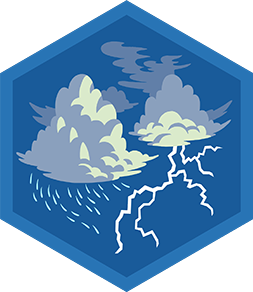Launch a weather balloon
Under adult supervision, build and safely launch a small model weather balloon with a thermometer and tracker to collect temperature and altitude data.



Step-by-step guide to launch a weather balloon
How To Start A Weather Balloon Launch Site? - Weather Watchdog
Step 1
Ask an adult to check local rules and to contact the nearest aviation authority or airport to make sure launching a small weather balloon is allowed and safe.
Step 2
Gather all the materials listed and put them on a clear workspace so everything is ready.
Step 3
Assemble the payload by placing the digital thermometer and the GPS tracker inside the payload container and positioning them so the sensors can work.
Step 4
Add padding around the instruments inside the container so they will stay safe during flight.
Step 5
Seal the payload container shut and tape all edges so nothing can fall out.
Step 6
Attach one end of the string securely to the payload container so it will hang straight and not come loose.
Step 7
Place the sealed payload on the kitchen scale and write down its weight so you know how much lift you need.
Step 8
Ask the adult to use the balloon packaging or the helium tank instructions to calculate how much helium is needed for your payload weight.
Step 9
Have the adult attach the regulator and carefully fill the balloon with helium to the calculated lift amount.
Step 10
Have the adult tie the balloon neck securely so helium cannot escape before launch.
Step 11
Turn on the GPS tracker and the thermometer and confirm each device is logging data and has fresh batteries.
Step 12
Go with the adult to a chosen open launch site and check that wind is calm and the area is clear of people and obstacles.
Step 13
Have the adult release the balloon now while you watch from a safe distance and note the launch time.
Step 14
Use the GPS tracker to follow the flight and, after the tracker shows the payload has landed, go with your adult to retrieve the payload.
Step 15
Download the temperature and altitude data and share your finished creation and findings on DIY.org
Final steps
You're almost there! Complete all the steps, bring your creation to life, post it, and conquer the challenge!


Help!?
What can we use if a helium tank or regulator is hard to find?
If a helium tank or regulator is hard to find, use a store-bought party helium canister and have an adult follow the balloon packaging instructions to calculate lift and fill the balloon safely.
What should we do if the balloon doesn't lift or the payload seems unstable?
If the balloon doesn't lift or the payload hangs unevenly, re-check the payload weight on the kitchen scale, redistribute or add padding inside the payload container, and have an adult add small amounts of helium per the packaging lift calculation with the regulator until it lifts.
How can we adapt the activity for different age groups?
For ages 5–8 have the adult handle the helium tank, regulator, and launch while the child assembles and pads the payload container and notes the launch time, for ages 9–14 let the child weigh the payload on the kitchen scale and follow the balloon packaging lift calculation with supervision, and for 15+ let them operate the GPS tracker, download the temperature and altitude data, and lead retrieval planning with an adult.
How can we extend or personalize the weather balloon project?
Enhance the project by adding a lightweight camera or extra sensors inside the payload container with additional padding, attaching a small parachute to improve landing recovery, and sharing your photos plus downloaded temperature and altitude data on DIY.org.
Watch videos on how to launch a weather balloon
How to Launch a Weather Balloon to the Edge of Space: STEM Project Guide
Facts about meteorology and weather measurement
⚠️ Helium is usually chosen for safety because hydrogen gives more lift but is highly flammable.
🧭 A tiny GPS tracker can log coordinates and altitude so you can find your payload after it lands.
💨 Many balloons ascend at about 5 m/s — a 20 km trip often takes around 1–2 hours.
🌡️ Radiosondes carry sensors that send back temperature, pressure and humidity as they climb.
🎈 Weather balloons commonly rise to about 30 km (100,000 ft) before they burst.
How do you launch a small model weather balloon safely with a child?
What materials do I need to launch a child-friendly weather balloon?
What ages is launching a model weather balloon suitable for?
What safety tips and benefits should families know about weather balloon launches?


One subscription, many ways to play and learn.
Only $6.99 after trial. No credit card required



